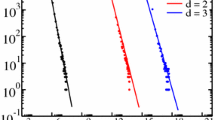Abstract
By sequentially adding line segments to a line or disks to a surface at random positions without overlaps, we obtain configurations of the one- and two-dimensional random sequential adsorption (RSA) problem. We have simulated the one- and two-dimensional problem with periodic boundary condition. The one-dimensional simulations are compared with the exact analytical solutions to give an estimate of the accuracy of the simulation. In two dimensions the geometrical properties of the RSA configuration are discussed and in addition known results of the RSA process are reproduced. Various statistical distributions of the Voronoi-Dirichlet (VD) network corresponding to the RSA disk configuration are analyzed. In order to characterize pores in the RSA configuration, we introduce circular holes. There is a direct correspondence between vertices of the VD network and these holes, and also between direct/indirect geometrical neighbors and these holes. The hole size distribution is found to be a parabola. We also find general relations that connect the asymptotic behavior of the surface coverage, the correlation function, and the hole size distribution.
Similar content being viewed by others
References
J. J. González, P. C. Hemmer, and J. S. Høye,Chem. Phys. 3:228 (1974).
L. Finegold and J. T. Donnell,Nature 278:443 (1979).
M. Hasegawa and M. Tanemura, inRecent Developments in Statistical Interference and Data Analysis, K. Matusita, ed. (North-Holland, Amsterdam, 1980).
J. Feder and I. Giaever,J. Coll. Interface Sci. 78:144 (1980).
B. Widom,J. Chem. Phys. 44:3888 (1966).
J. Feder,J. Theor. Biol. 87:237 (1980).
Y. Pomeau,J. Phys. A: Math. Gen. A13:L193 (1980).
R. H. Swendsen,Phys. Rev. A 24:504 (1981).
A. Renyi,Publ. Math. Inst. Hungar. Acad. Sci. 3:109 (1958). English Translation:Sel. Trans. Math. Stat. Prob. 4:203 (1963).
J. K. Mackenzie,J. Chem. Phys. 37:723 (1962).
B. Widom,J. Chem. Phys. 58:4043 (1973).
B. E. Blaisdell and H. Solomon,J. Appl. Prob. 7:667 (1970).
W. S. Jodrey and T. M. Tory,J. Statist. Comput. Simul. 10:87 (1980).
E. M. Tory, W. S. Jodrey, and D. K. Pickard,J. Theor. Biol. 102:439 (1983).
M. Tanemura,Ann. Inst. Stat. Math. 31B:351 (1979).
J. D. Bernal,Proc. Roy. Soc. Lond. A280:299 (1964).
J. L. Finney,Proc. Roy. Soc. Lond. A319:479 (1970).
R. Zallen,The Physics of Amorphous Solids (John Wiley & Sons, New York, 1983).
H. S. M. Coxeter,Introduction to Geometry, 2nd ed. (John Wiley & Sons, Toronto, 1969).
Author information
Authors and Affiliations
Rights and permissions
About this article
Cite this article
Hinrichsen, E.L., Feder, J. & Jøssang, T. Geometry of random sequential adsorption. J Stat Phys 44, 793–827 (1986). https://doi.org/10.1007/BF01011908
Received:
Revised:
Issue Date:
DOI: https://doi.org/10.1007/BF01011908




